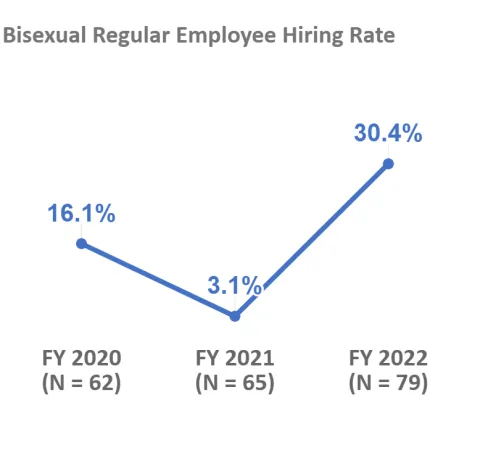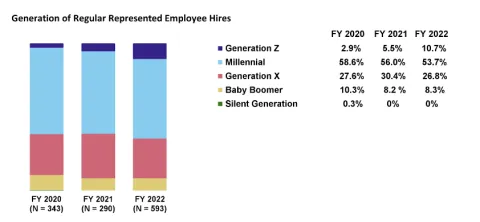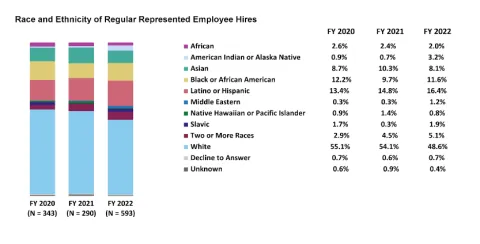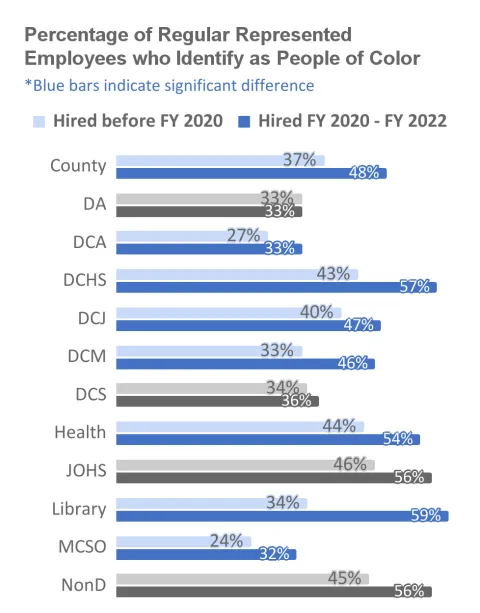On this page
- Race and Ethnicity: Hire Rate Increased for American Indian or Alaska Native Regular Employees
- Sexual Orientation: Hire Rate for Regular Represented Bisexual Employees is Increasing
- Generation: Percentage of Regular Represented Employees from Generation Z is Increasing
- Racial and Ethnicity: Diversity Increasing among Regular Represented Hires
- Race and Ethnicity: Diversity Higher among New Hires Compared to Employees Hired Before FY 2020
For the purposes of this report, we focus on data of employees who were hired or rehired. This report does not examine the hiring process, including candidate demographics, demographics of candidates who meet minimum qualifications, or other movement through the application or hiring process. This report also does not include analysis of vacancies or recruitment processes. All of these factors would be essential to truly understanding whether employees have equitable access to hiring.
We examined the demographic data of employees hired between FY 2020 and FY 2022 to help understand hiring trends in the workforce.
We found that for Regular employees, there were statistically significant results related to hiring depending on:
- Race and ethnicity
- Generation
- Sexual Orientation
Countywide, there were no statistically significant hiring rate results based on other demographic categories for which we had data, including Disability, Gender, and Veteran status. You may view those hiring rates in the hiring dashboards. Department-specific results can be found in the departmental summaries and dashboards.
Race and Ethnicity: Hire Rate Increased for American Indian or Alaska Native Regular Employees
We assessed newly hired employees to identify any significant differences in the hire rate within employee demographic groups. The hire rate of all Regular employees who identified as American Indian or Alaska Native was 8.0% in FY 2020 and 4.0% in FY 2021. Then, in FY 2022, the hire rate increased to 29.7%, a statistically significant increase.
There were no other statistically significant differences in any other race and ethnicity groups among newly hired Regular employees. However, you can view the hiring rates for all race and ethnicity groups in the dashboards.

Sexual Orientation: Hire Rate for Regular Represented Bisexual Employees is Increasing
Information about employees’ sexual orientations is mostly unknown, as approximately two-thirds of employees do not have their sexual orientation information entered into Workday. Analyses of employment actions in relation to sexual orientation can only be performed where this information is known. Therefore, results from these analyses may not accurately reflect the trends for all employees based on their sexual orientation and should be interpreted with these limitations in mind. We hope to have more complete sexual orientation data in the future and we encourage employees to enter their demographic information into Workday.
The hire rate for Bisexual all Regular employees was 16.1% in FY 2020. After a significant decrease to 3.1% in FY 2021, there was a significant increase to 30.4% in FY 2022.

Generation: Percentage of Regular Represented Employees from Generation Z is Increasing
The percentage of Regular Represented employee hires from Generation Z is significantly increasing as they enter the labor pool. In FY 2020, the percentage of Regular Represented employees hired from Generation Z was 2.9%. The percentage significantly increased to 5.5% in FY 2021 and again significantly increased to 10.7% in FY 2022. The percent of Millennials was over 50% of all Regular Represented hires between FY 2020 and FY 2022 while the hire rate for Generation X was around 30% during the same period. Baby Boomers constituted around 10% of Regular Represented employees hired between FY 2020 and FY 2022.

Racial and Ethnicity: Diversity Increasing among Regular Represented Hires
We examined the demographic data of employees hired between FY 2020 and FY 2022 to help the County understand hiring trends.

The racial and ethnic diversity of Regular Represented employees hired between FY 2020 and FY 2022 has increased steadily. In FY 2020 and FY 2021, the majority of Regular Represented employees who were hired identified as White — 55% in FY 2020 and 54% in FY 2021 — while Regular Represented employees identifying as Black, Indigenous or other people of color made up 44% of new hires in FY 2020 and 44% of new hires in FY 2021. However, in FY 2022, the percentage of newly hired Regular Represented employees identifying as White dropped to 49%, while newly hired Regular Represented employees who identified as a People of Color rose to 50%.
More specifically, the proportion of Regular Represented new hires who identified as Latino or Hispanic increased from 13% in FY 2020 to 15% in FY 2021, then 16% in FY 2022. Other race and ethnicity categories also saw fluctuations and increasing trends over this period, but there were no statistically significant changes. Altogether, the proportion of regular represented employees that were hired during this three year period has increased and helps to explain the increasing diversity of the overall countywide workforce.
For Regular Non-represented hires, there were no statistically significant changes in the proportion of race and ethnicity groups from FY 2020 to FY 2022. You can view hiring rates and proportions for all race and ethnicity groups by employee type in the dashboards.
Race and Ethnicity: Diversity Higher among New Hires Compared to Employees Hired Before FY 2020

Our analyses found that the countywide workforce of Regular employees became more diverse, with the proportion of BIPOC employees increasing from FY 2020 to FY 2022. Additionally, Regular Represented hires were more racially and ethnically diverse in FY 2022 compared to FY 2020 and FY 2021.
To examine this further, we divided Regular Represented employees into two groups: those who were hired between FY 2020 and FY 2022, and those who were hired prior to the start of FY 2020. We then compared the proportion of Regular employees who identified as people of color between these two groups.
We found that 37% of Regular Represented employees who were hired before FY 2022 identified as people of color. That proportion increased to 48% among Regular Represented employees who were hired between FY 2020 and FY 2022 — an 11% jump that is statistically significant.
Among 11 individual County departments, seven showed statistically significant increases in the proportion of their Regular Represented employees of color who were hired before FY 2020 and hires after FY 2020: Department of County Assets, Department of County Human Services, Department of Community Justice, Department of County Management, the Health Department, Library, and the Multnomah County Sheriff’s Office.
Three departments also showed increases that were not statistically significant: the Department of Community Services, the Joint Office of Homeless Services (JOHS is a small department, which may be why the results did not reach statistical significance), and Non-departmental offices. The District Attorney’s Office did not have a change in the proportion of Regular Represented employees of color. No departments had a decline in the proportion of Regular Represented employees of color.
The Library had the largest increase in the proportion of Regular Represented employees who identified as BIPOC between employees hired before FY 2020 and employees hired between FY 2020 and FY 2022, rising from 34% to 59% between the two groups.
For Regular Non-represented employees, there were no statistically significant differences between the proportion of employees who identify as BIPOC between employees hired before FY 2020 and employees hired between FY 2020 and FY 2022.
Go to the next section: Promotions
